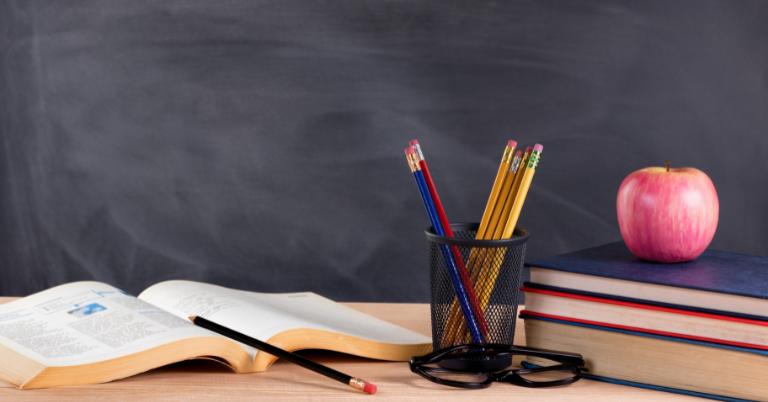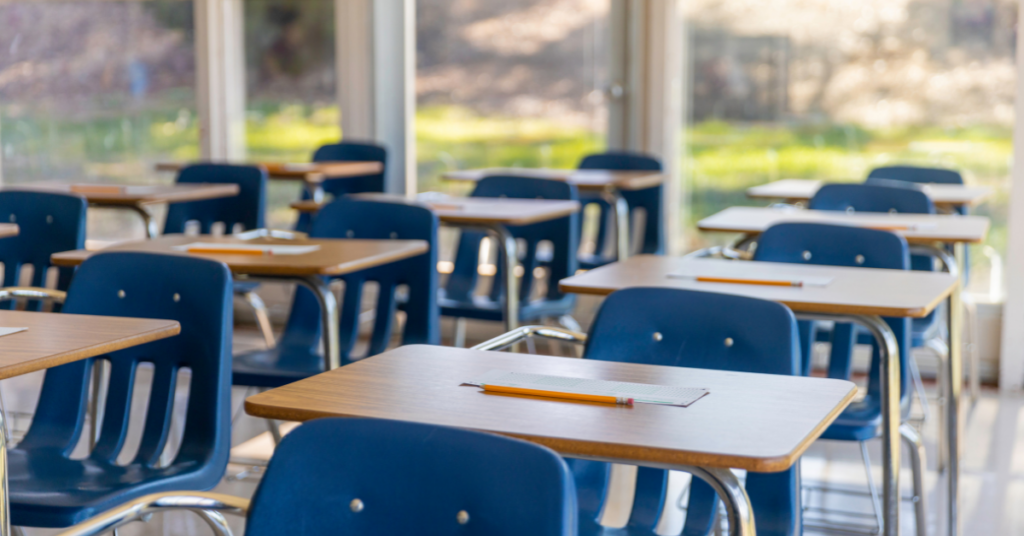Even though students spend more than 30 hours per week in school, many parents and caregivers don’t know if their child’s learning environment is LGBTQ+ inclusive. Guest resource author, Lori Burns, Ed. D., is taking a look at six easy ways to tell.
It’s true that a lot of schools in the US have a long way to go to create safe, affirming environments for LGBTQ+ students, staff, and families. But with parent advocates who are clued into their child’s learning, school leaders can enact positive change.
And, often the first step to creating positive change is assessing areas for improvement. Below are six easy things to look for to determine the level of LGBTQ+ inclusivity in your child’s school.
Are the lessons LGBTQ+ inclusive?
You can tell a school’s values and objectives by looking at what they teach—or don’t teach—in lessons. That’s why it’s so important for LGBTQ+ students and families to see themselves reflected in lessons. Excluding LGBTQ+ topics and people further isolates and shames these students. It also hinders the comprehensive education of all students because lessons that are solely based on non-LGBTQ+ topics perpetuate an exaggerated sense of self-worth within non-LGBTQ+ students and a false sense of what the world is like.
The majority of schools in the United States do not offer LGBTQ+ inclusive lessons and resources. In fact, there are only 4 states that require schools to offer LGBTQ+ inclusive lessons in history classes (California, Colorado, New Jersey, and Illinois), and New Jersey is the only state in the US that requires public schools to offer LGBTQ+ inclusive lessons in all subject areas. While it is helpful for states to mandate LGBTQ+ inclusivity, it is not required. Most content standards align to equitable instruction rooted in culturally responsive lessons. Here are some examples of LGBTQ inclusive lessons and concepts that parents/guardians should look for:
Literature
- Does the class read books with LGBTQ+ characters?
- If so, do the LGBTQ characters represent positive characteristics or negative characteristics? (Historically, books depict LGBTQ+ characters as evil, mentally ill, and dangerous.)
- Do the books read in class indirectly discuss LGBTQ+ themes like in The Picture of Dorian Gray by Oscar Wilde or The Color Purple by Alice Walker?
- Does the class read books by LGBTQ+ authors?
- Does the class poetry sections examine LGBTQ+ themes?
History
- Do the lessons address the social, political, and economic contributions of LGBTQ+ people?
- Is the LGBTQ+ related information accurate?
- Does the LGBTQ+ related information in lessons begin with the Stonewall riots? If so, this is a limited viewpoint on LGBTQ+ history. LGBTQ+ history dates back to ancient civilizations.
- Does the textbook or online resource offer LGBTQ+ representation?
World Language
- Does the lesson compare and contrast culture norms regarding gender and sexual orientation?
- Is gender-specific language examined?
- Does the lesson explore the cultural perceptions of beauty as it relates to gender and sexual orientation?
Science
- Does the section on heredity and genetics review the different kinds of families and the various ways of conception, such as surrogacy, in vitro fertilization (IVF), and egg donation and the impact on heredity and genetics?
- Is there a lesson regarding intersex individuals? 1 in 60 people identify as intersex, yet most science curricula don’t discuss this group.
- Does the lesson prompt students to examine their perceptions of what a scientist looks like?
- Does the unit on the animal kingdom reference the existence of same-sex relationships and gender roles within the animal kingdom?
Math
- Do students analyze LGBTQ+ specific data such as the statistics from the Gay, Lesbian & Straight Education Network (GLSEN) National Climate Survey?
- Do word problems use LGBTQ+ inclusive language, characters, and themes?
Visual & Performing Arts
- Is the historic underrepresentation of LGBTQ+ women of color in art history and museum collections discussed?
- Is the power of media regarding identity, specifically gender and sexual orientation, discussed?
- Does the class discuss LGBTQ+ censorship?
Health
- Is the Health curriculum an abstinence-only curriculum? These kinds of classes rarely discuss LGBTQ+ topics.
- Does the class discuss same-sex families in the family section?
- Are LGBTQ+ relationships discussed during the relationship section?
- Does the class only discuss LGBTQ+ people when learning about HIV/AIDS?
Finding signs of LGBTQ+ Inclusivity in Classrooms and School Buildings
When entering a school building, families should be aware of what they do and do not see. Both are indicators of whether the school environment is safe and affirming for LGBTQ+ people. Examples of visible signs of inclusivity around the school building include, but not limited to, Safe Space stickers, Pride flags, and bulletin boards regarding diversity, inclusion, and possibly the school’s Gay-Straight Alliance/Gender and Sexuality Alliance (GSA) club. Gender-neutral bathrooms for students and staff members would also be a strong indicator of LGBTQ+ inclusion in schools.
Visible signs of inclusivity in the classroom include, but are not limited to, LGBTQ+ specific classroom rules regarding appropriate language, LGBTQ+ stickers and magnets on the furniture/walls, and LGBTQ+ pins on the teacher’s lanyard. In addition, images or quotes from LGBTQ+ heroes such as Harvey Milk and Bayard Rustin are clear indicators of a safe and affirming learning environment for LGBTQ+ students and families. Indirect examples of LGBTQ+ inclusion would be book displays of prolific LGBTQ+ authors such as Audrey Lorde, James Baldwin, and Oscar Wilde and LGBTQ+ specific books that are age-appropriate and align to the content area.
Looking for LGBTQ+ Inclusivity in School Practice
The manner in which teachers and administrators speak is also an indicator of the school’s level of LGBTQ+ inclusivity. Educators should use gender-neutral language at all times. For instance:
- Use “Good morning, friends!” or “Good morning, scholars!” instead of “Good morning, boys and girls!”
- Use “Who is picking you up today?” instead of “Is mommy or daddy picking you up today?”
Similarly, schools shouldn’t be grouping students together by gender during lessons. Dismissing girls first and then boys or creating a “girls team” and a “boys team” in physical education classes is an example of this antiquated practice. Additionally, schools that require traditional gender expression in dress codes or at school recitals and ceremonies isn’t appropriate.
Are the school forms LGBTQ+ inclusive?
Often, the first encounter that employees and parents have with a school or school district is filling out an application or registration form. So, the language used on school forms becomes an indicator of the school’s level of LGBTQ+ inclusion. For instance, job application forms should offer more than 2 selections for gender. Student registration forms, physical forms, and all parent communication forms should have more than 2 indicators for gender and should list “parent/guardian 1” and “parent/guardian 2” rather than “father” and “mother.”
Assessing the school’s policies
Regardless of whether a state mandates LGBTQ+ inclusive policies in schools, school leadership should draft and approve LGBTQ+ specific policies that outline their stance on the expected support and treatment given to LGBTQ+ students and staff members. The policy should offer clear guidance regarding LGBTQ+ specific professional development for staff members, dress code, school records, extracurricular activities, use of facilities, social-emotional support, and LGBTQ+ inclusive lessons and resources.
Is the media center LGBTQ+ inclusive?
The media center within schools can be a valuable resource for LGBTQ+ inclusive materials and lesson plan development. So, the media center should display LGBTQ+ authors and LGBTQ+ themed books that are age-appropriate for students and teachers. Additionally, the media center should display LGBTQ+ authors and books throughout the school year, not just during Pride month in June.
Similarly, while LGBTQ+ websites are often blocked by district firewalls, online access to LGBTQ+ resources is necessary for teachers to develop inclusive lessons and for students to access accurate information. The Media Specialist can serve as a strong resource for teachers to select LGBTQ+ inclusive materials that are age-appropriate and align to the content area. Therefore, curriculum and instruction meetings with teachers and administrators should also include Media Specialists.
Once you can assess your child’s learning environment, you can start working with school leaders and teachers to improve the conditions of that environment for LGBTQ+ students, staff members, and families. While it’s tough to know where to start, Family Equality aims to assist LGBTQ families in working with their child’s school leaders and teachers to ensure a safe and affirming environment. Stay connected to us online and in-person for more information regarding LGBTQ inclusive school environments and best practices for change.
About the Author:
Dr. Lori Burns is a public school principal in New Jersey and Adjunct Professor at Monmouth University. Dr. Burns is the co-founder of Educators for Equality, a grassroots organization of LGBTQ educators and allies who work toward building safe and affirming work environments for LGBTQ teachers and school leaders. Dr. Burns also acted as the LGBTQ Inclusive Lessons and Resources Pilot Program Manager in which she worked collaboratively with Garden State Equality and Make It Better for Youth to study the impact of LGBTQ lessons and resources on teachers, administrators, and school climate of public schools in the state of New Jersey.
Dr. Burns identifies as a lesbian and is a proud wife and mother of two children. She is passionate about the importance of LGBTQ family involvement in schools and LGBTQ visibility in schools. Follow her work regarding best practices for LGBTQ inclusive lessons, resources, and schools on Twitter and Instagram @drloriburns.



